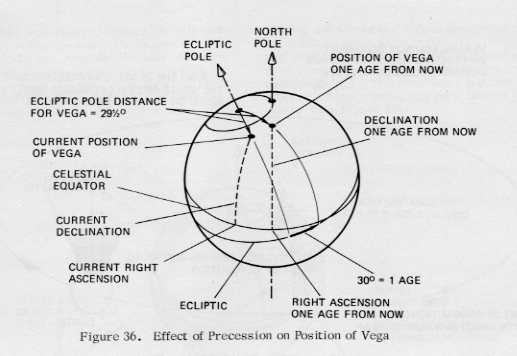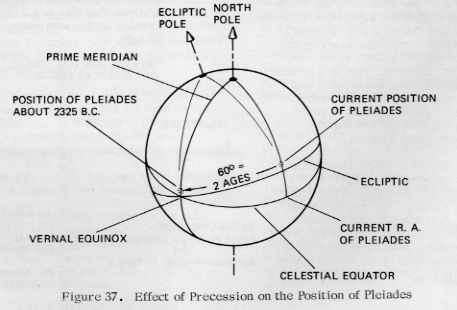

|
EFFECTS OF PRECESSION To see the effect upon a star's position due to precession, it is only necessary to move the star's position on the celestial globe about the pole of the eclioptic by a given angle. See Figure 36. If we are interested in the position of Vega one age from now or 2,150 years from now, in the year 4125 A.D. we move the current position of Vega counter-clockwise about the north ecliptic pole by 30°. Its current distance from the ecliptic pole is 29 1/2° and after it is move it will still be 29 1/2° from the ecliptic pole, but in a position about half-way beween the current postions of Vega and Deneb. Its declination will be 42° and its R.A. will be 19 h 40 m. Of course all other stars will also have moved. Polaris, the current pole star will be at a polar distance of 12°, and its R.A. will be 12 h 45 m. Here we have ignored the change in the declination of the earth's pole with respect to the ecliptic. |
The star Regulus in Cancer(s) will have moved down to a position almost over the equator. To go back in time we must move the stars in a clockwise direction about the north ecliptic pole. For example, tow ages ago (60° clockwise), or 4,300 years ago in the year 2,325 B.C., the Pleiades were about 4° north of the equator and just west of the vernal equinox. See Figure 37. In fact, the Pleiades were used by some people to indicate the beginning of the new year. When the Pleiades were on the meridian at midnight, the sun was at the autumnal equinox and the new year was started. About 2 1/6 ages ago, (65° clockwise) or about 2,600 B.C., the star Thuban or Alpha Draconis was the pole star. It is believed that the descending tunnel in the Great Pyramid Cheops was aligned to sight towards Thuban at its lower culmination. |

| Page 20 |